|
|
|
|
September 2022

Bells of Peace is a U.S. national “bell tolling” remembrance created in collaboration with the Society of the Honor Guard, Tomb of the Unknown Soldier (SHGTUS) to commemorate the 100-year anniversary of the World War I Armistice, November 11, 2018. The Doughboy Foundation has since promoted it as an annual remembrance of those who served in WWI and of the moment when the guns fell silent, and bells tolled on the Western Front… on the 11th day of the 11th month, at the 11th hour in 1918, after four years of brutal combat. Pease click anywhere on the image above to find out more about how to participate in Bells of Peace in 2022.
|
|
Jerry Looper Hester, 1931–2022

Jerry Hester, one of the original twelve Commissioners at the establishment of the U.S. World War I Centennial Commission in 2013, has died at age 90 in North Carolina. Jerry’s indomitable determination was utterly essential to the establishment of the Commission, the broad national commemoration of the Centennial of World War I, and the construction of the new National World War I Memorial in Washington, DC. Jerry’s obituary is available here. An In Memoriam essay honoring “One of the most inexhaustible and effective soldiers in the effort to honor the Americans who served and sacrificed their nation in the First World War” is available here. The U.S. World War I Centennial Commission and the Doughboy Foundation mourn Jerry’s passing.
|
Verizon goes back to school with new immersive learning content, including the WWI Memorial “Virtual Explorer“

As students head back to school, Verizon is continuing to bolster immersive learning content across its award-winning Verizon Innovative Learning education initiative. Verizon’s impactful partnerships with trusted education companies, edtech innovators ,and cultural institutions enable educators to access new tech-driven lesson plans that utilize the power of augmented reality (AR) and virtual reality (VR) apps in the classroom, such as the Doughboy Foundation’s WWI Memorial “Virtual Explorer.” The Memorial app introduces a next generation of young adults to the transformational impact WWI had on America. Click here to read more about this exciting new immersive learning content initiative.
|
Four more “Rush Hour” concerts by the U.S. Army Band “Pershing’s Own” will round out September at The National World War I Memorial in Washington, DC
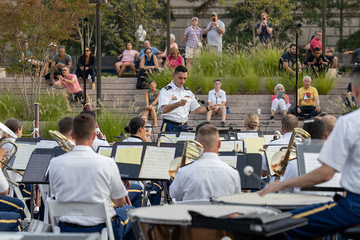
The U.S. Army Band “Pershing’s Own” will make September finish on a high note with four more Thursday Evening Rush Hour Concerts at the National World War I Memorial in Washington, DC weekly this month. The concerts are part of the band’s 100th anniversary year. Here are the remaining dates and times (weather permitting) for the 2022 concert series:
- Thursday, September 8, 6:00 pm, Army Band ensemble
- Thursday, September 15, 6:30 pm, Concert Band
- Thursday, September 22, 6:00 pm, Army Band ensemble
- Thursday, September 29, 6:00 pm, Army Band ensemble
The Band starts to set up at the Memorial after the completion of Daily Taps at 5:00 pm, and the concerts begin promptly at 6:00 pm (6:30 pm on September 15). There is plenty of seating at the Memorial with good views of the band. Check the Band’s web site or social media to determine the status of the event in case of inclement weather on a concert day, or any changes in starting times.
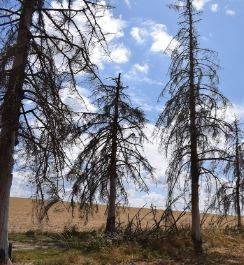
The beautiful spruce trees that lined the road leading to the 316th Infantry Regiment monument above Sivry-sur-Meuse in France are now dead or dying from the region-wide infestation of the spruce bark beetle ravaging the Argonne region. This is one of the most iconic monuments in the area, and the hilltop offers one of the best views of the battlefield that exists. Some 50 trees need to be removed, and (hopefully) replaced. The trust fund set up by the 316th veterans that pays for the monument’s maintenance has insufficient funds to remove all the dead and dying trees. A GoFundMe campaign has been set up to supplement the trust fund, so the the work on the trees can take place. Click here to read more, and learn how you can help support this recovery effort at a unique WWI monument.
|

Soldiers assigned to U.S. Army Southern European Task Force, Africa joined members of the Italian Army, Aug. 28, near Gallio, Italy, to honor those who were killed in action during World War I while defending Vicenza and Venice, Italy.The Bersaglieri Brigade of the Italian Army celebrated its annual pilgrimage to Cima Valbella near Gallio, to honor the sacrifice of the Bersaglieri soldiers of the 5th and 14th Regiment in the ‘Great War.’ Click here to read more, and learn how, to remember the battle, the Italian and U.S. soldiers hiked 40 minutes to the top of Mount Valbella for memorial services..
|
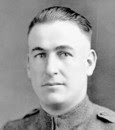
Manuel E. Reams Jr. was a cattleman and former baseball player when he was drafted into the U.S. Army during World War I. He was killed Oct. 31, 1918, the first day of the Ypres-Lys Offensive. He was 27.Fifteen months later, on the evening of Jan. 7, 1920, in the Odd Fellows Hall in Suisun City, 37 men who had served in the Army, Navy and Marine Corps during the Great War voted to create California American Legion Post 182 and named it after Reams. That post, from Sept. 5-10, will be honored at 5 p.m. each evening with the playing of Daily Taps at the World War I Memorial in Washington, D.C. Click here to learn more about Manuel E. Reams Jr., and the Daily Taps program.
|
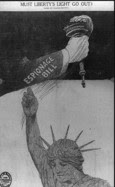
The FBI investigation into possible Espionage Act violations by former President Donald Trump has sparked curiosity about the World War I-era law. The Espionage Act was passed by Congress and signed by President Woodrow Wilson in a climate of xenophobia and anti-Red hysteria in 1917, the year the U.S. entered WWI. But because many Americans opposed fighting in what they viewed as a war between European colonial powers, Congress included provisions allowing the federal government to crack down on dissent. Click here to read more, and learn how the Espionage Act, despite its name, has rarely been used to punish actual espionage.
|
Women in a World Designed for Men:
a World War I librarian and a Naval Academy plebe confront injustice
“World War I History Is Wrong, and Skewing Our View of China”
 |
|
General of the Armies
John Joseph Pershing
Born September 13, 1860
|

A man is only missing if he is forgotten.
Our Doughboy MIA this month this time around is a man we just searched for in August: PVT Edward Michael McAvoy ASN3193251 M CO/314th INF/79 DIV – KIA September 26th, 1918.
Edward Michael McAvoy was born in Benedicta, Maine on 28MAR1887, to Mary T McAvoy. Little is known of his father other than his death in occurring in 1908. Mary McAvoy had two sons, the other being Frederick McAvoy. On draft registration day Edward listed his home address as Webster, Massachusetts and his occupation as shoemaker. He is described as tall and slender with brown hair and brown eyes. He claimed no exemption from service.
He was inducted into service at Southbridge, Massachusetts on 26MAY1918 and sent to Camp Upton in New York for induction and assigned to the 8th CO/152nd Depot Brigade. From there he was transferred to the 79th Division at Camp Meade, Maryland on 22JUN1918 and assigned to M CO/314th/79 DIV on 27JUN1918. He sailed with his new unit to France from Hoboken, New Jersey aboard the USS Leviathan on July 8th, 1918.
Upon arrival in France on the afternoon of July 15th 1918, the 314th Infantry was sent towards the 10th Training area where it trained under French officers until September 7th, when they took up positions in the Avocourt-Malancourt sector to partially relieve the French in defensive positions near Hill 304 in preparation for the Meuse-Argonne offensive. M CO/314th Infantry spent most of this time in reserve, creating defensive positions and assisting in repairing roads. On the Morning of September 26th 1918, the 79th Division went into attack against Butte d’Montfaucon. Montfuacon sat on top of a large hill, making it a key part of the German defensive line, where German artillery observers used it to great advantage, directing artillery on American positions. In order for the American offensive to be successful, the 79th DIV had to capture Montfaucon as soon as possible. The position was fortified with a series of consecutive trench systems, bunkers, and machine gun nests. The 79th were under orders to capture the butte by the end of the day. At 5:30am on the morning of September 26th 1918, Co M/314th infantry moved forward toward Malancourt, supported by the 315th Infantry. Under a heavy smoke screen, they appeared in front of the first line of German defenses and took the German machine gun nests head on. By the afternoon the Company found itself again taking on heavy machine gun fire while taking the second line of German trenches. That was as far as they were able to get; the company reorganized and stayed overnight in the second line of trenches. The Germans were only a few hundred yards away and harassed Co M/314th with machine gun and sniper fire the entire night. It was there, around 9:00 pm, that PVT McAvoy was struck by a bullet in the stomach and died almost instantly. He was buried by the regimental chaplain.
Following the war, his family was first informed that PVT McAvoy had been recovered and buried in the nearby newly established Meuse-Argonne American Cemetery, however this was found to be in error and in 1921 an investigation was initiated. It was found that PVT McAvoy had not been recovered and despite further searching by GRS field personnel his remains went unlocated.
Doughboy MIA was asked by Nancy Schaff and leaders of the 314th Infantry Historical Association to look into the case, which we did. Robert Laplander did the initial work on the case in 2017, which was found to have good merit, and it was then handed to Alexander Curran for further examination. In late 2021, the case was presented to the team by Alexander with the recommendation for possible recon on site in the 2022 season, and this past August the team did indeed spend a day on the site that the research pinpointed. Our findings are encouraging and will be discussed in an upcoming Zoom call tentatively scheduled for the last week of September. Stay tuned for more details on that, and we look forward to YOU attending the call and seeing just what your contributions are accomplishing to get our lost Doughboys found.
Want to donate and be part of the action? Hop on over to www.ww1cc.org/mia or www.doughboymia.org and make a tax-free donation to our non-profit and help us find these boys, and we’ll see YOU soon on the Zoom!
A man is only missing if he is forgotten.
Can you spare just ten dollars? Give ‘Ten For Them’ to Doughboy MIA and help us make a full accounting of the 4,423 American service personnel still listed as missing in action from WW1. Make your tax deductible donation now, with our thanks.
|
Merchandise from the Official
Doughboy Foundation WWI Store
|
|
|
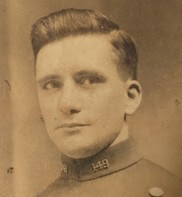
Submitted by: Brian Basel {Grandson}
George Anthony Basel was born around 1890. George Basel served in World War 1 with the United States Army. The enlistment was in 1918 and the service was completed in 1919.
Story of Service
Served in the U.S. Navy for four years as a Machinist Mate First Class on four ships prior to World War One.
Enlisted in the Army on April 4, 1918 and was stationed at Camp Upton, Yaphank, NY, with the 28th “Keystone” Infantry Division. He served overseas in France from May 4, 1918 with Company H, 2nd Battalion, 111th Infantry Regiment and then with Company B, 3rd Battalion.
His battle campaigns include Champagne-Marne, St. Muhiel, and Meuse-Argonne at Toul Sector. He was wounded in the right hand and shoulder on July 17, 1918 clearing the woods (Bois D’Aigremont) over the Paris Metz Road between Crezancy and Fossoy and was taken to Base 45 at Blois, France for recovery. He rejoined Company H on October 10, 1918 as it passed through Mountblainville, France.
Being fluent in German, when his unit returned home April 18, 1919, he remained overseas serving as an interpreter.
|

|
|
|
|
